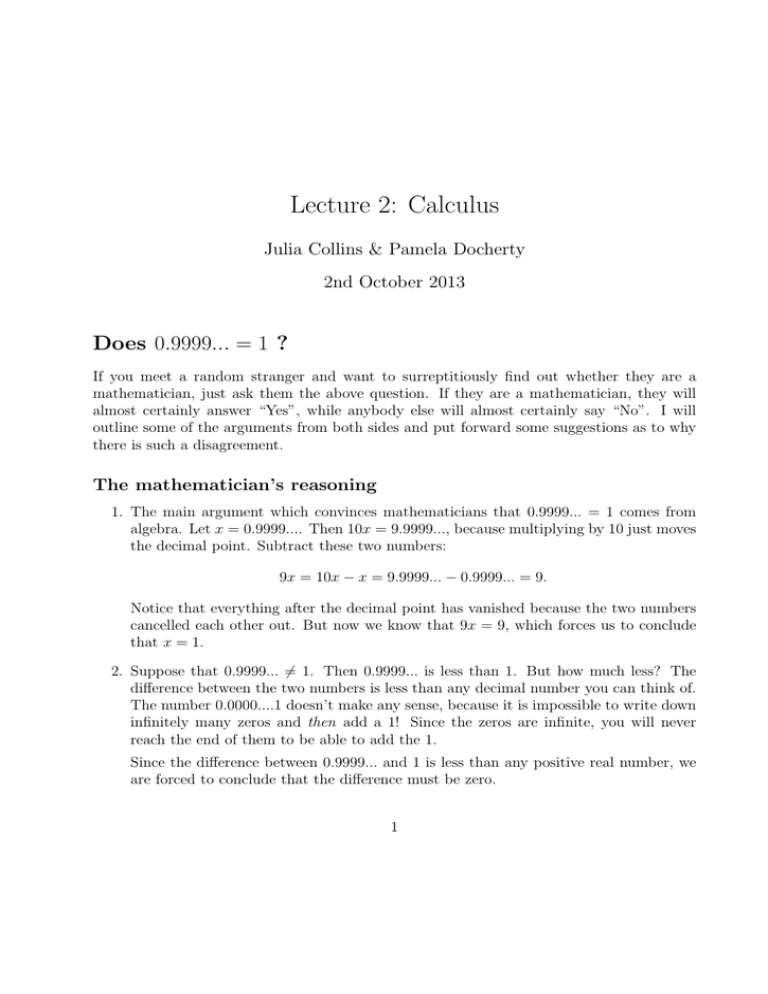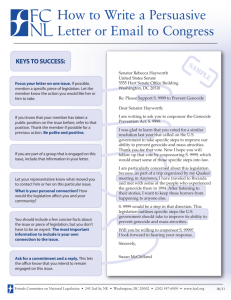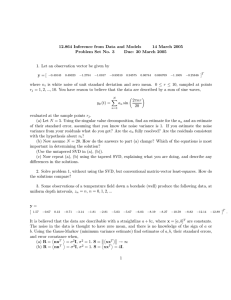Notes for Lecture 2
advertisement

Lecture 2: Calculus Julia Collins & Pamela Docherty 2nd October 2013 Does 0.9999... = 1 ? If you meet a random stranger and want to surreptitiously find out whether they are a mathematician, just ask them the above question. If they are a mathematician, they will almost certainly answer “Yes”, while anybody else will almost certainly say “No”. I will outline some of the arguments from both sides and put forward some suggestions as to why there is such a disagreement. The mathematician’s reasoning 1. The main argument which convinces mathematicians that 0.9999... = 1 comes from algebra. Let x = 0.9999.... Then 10x = 9.9999..., because multiplying by 10 just moves the decimal point. Subtract these two numbers: 9x = 10x − x = 9.9999... − 0.9999... = 9. Notice that everything after the decimal point has vanished because the two numbers cancelled each other out. But now we know that 9x = 9, which forces us to conclude that x = 1. 2. Suppose that 0.9999... 6= 1. Then 0.9999... is less than 1. But how much less? The difference between the two numbers is less than any decimal number you can think of. The number 0.0000....1 doesn’t make any sense, because it is impossible to write down infinitely many zeros and then add a 1! Since the zeros are infinite, you will never reach the end of them to be able to add the 1. Since the difference between 0.9999... and 1 is less than any positive real number, we are forced to conclude that the difference must be zero. 1 3. We define the number 0.9999... to be the limit of the sequence of numbers 0.9, 0.99, 0.999, 0.9999, ... Mathematically, the limit of a sequence of numbers x1 , x2 , x3 , . . . is defined to be the number L if the sequence gets arbitrarily close to L. That is, given any specified degree of accuracy, the terms in the sequence will eventually get that close to the number L. This is exactly what is happening with 0.9999...: we can get to within any distance of 1 by truncating the decimal accordingly. This is the only real way to make sense of the infinity in the statement. We turn it into a statement about finite quantities, which we do understand! Everyone else’s reasoning 1. The first argument that most people will give against 0.9999... = 1 is that 0.9999... is approaching 1 but it never reaches it. It is always infinitesimally smaller than 1. Because you need to go infinitely far in the sequence to get to 1, you will never get there. But does that mean that 0.9999... is not actually a number, but instead a process? 2. It doesn’t seem right that there could be two possible ways to write down each number. In the same way that 0.9999... = 1, you would also argue that, say, 8.25 = 8.249999.... Wouldn’t this ambiguity in numbers mess up our rules of arithmetic? 3. In the algebraic argument above, timesing by 10 doesn’t make sense. Firstly, when we multiply numbers we multiply from the right (just try doing 83917 × 3, for example!), but we can’t multiply 0.9999... by anything because the ‘infinity’ means we can never even get started. There is also the argument that when we times by 10, we ‘lose’ the number on the end. Like if we do 87.456 × 10 we get 874.56 and it goes from 3 decimal places to 2. Does ∞ − 1 still equal ∞, or is it something ever-so-slightly smaller? Discussion People’s arguments in the last section are very reminiscent of Zeno’s paradoxes, written back in 4̃50BC by the Greek philosopher Zeno. His most famous paradox is probably that of Achilles and the tortoise: in a race where the tortoise has a head start, Achilles can never catch up. This is because he always has to run to where the tortoise used to be, but in that span of time the tortoise has moved on a bit further. Achilles may get closer and closer to the tortoise, but he will never reach him. Another of Zeno’s paradoxes was that of motion. He argued that things can never move, because for an object to move somewhere they would first have to move halfway there. But 2 before that they would have to move a quarter of the way there. But before that they have to move an eighth of the way there, etc, thus having to move an infinite number of steps before they can get started. This is essentially the same as the argument that we can’t multiply 0.9999... by anything because we have to ‘get past the infinity’ first. The barrier to understanding anything is the concept of infinity, which is certainly a strange beast. It is a huge mental leap to go from ‘a very large number of objects’ to ‘an infinite number of objects’, and our intuition refuses to let our brains make this leap. When people disagree with 0.9999... = 1, it is usually because they think of 0.9999... as a number with a very large number of nines on the end, rather than a number with a truly infinite number of nines. And indeed, if you truncate the decimal anywhere, then the number WILL be less than 1! It was not until the 18th century, with the work of men like Cauchy and Weierstrass, that we were able to truly understand infinity and make the concept rigorous. The definition of a limit, given above, is part of our understanding of infinity. And yet, in the 1960s there was a resurgence in the idea of there being such mathematical objects as ‘infinitesimals’: numbers that are smaller than any decimal number, and yet not zero. It is very tricky to make these ideas rigorous, and you can see how difficult the subject is by reading the Wikipedia article: http://en.wikipedia.org/wiki/Non-standard_analysis The majority of mathematicians have taken no notice of this theory, and it has not provided any new results that we couldn’t have proved without it. But it does at least show that our intuition is not entirely wrong! The Harmonic Series The harmonic series is the infinite sum 1+ 1 1 1 1 1 + + + + + ... 2 3 4 5 6 where the denominators go up one at a time. It is a surprising fact that although the terms of the sequence are getting smaller and smaller, the sum of all the infinitely many terms is not 1 +. . . any finite sensible number but is infinite. (This is in contrast to a sum like 21 + 14 + 81 + 16 which is actually equal to 1.) How do we prove that the harmonic series is infinite? We do the adding up bit by bit in a clever way. Notice that • 1 3 + 1 4 > 1 4 + 1 4 = 1 2 3 • 1 5 + 61 + 17 + • 1 9 + 1 10 1 8 + ··· + > 1 16 1 8 + 81 + 18 + > 1 16 + 1 16 1 8 = 1 2 + ··· + 1 16 = 1 2 and so on, taking twice the number of terms each time. This means that the harmonic series is bigger than 1 1 1 1 1 + + + + + ... 2 2 2 2 which is clearly infinite. What is even more mind-boggling is that if you make every second term in the sum negative, so you get the sum 1 1 1 1 1 1 − + − + − + ... 2 3 4 5 6 then the answer can be anything you want it to be because if you change the order you add up the terms then you get different answers! This never happens when there are only +’s in the sum. The result is called the Riemann Series Theorem and is very difficult to prove! You might be interested in the Wikipedia article: http://en.wikipedia.org/wiki/Riemann_ series_theorem which contains some examples of the rearranging and a difficult proof. Homework problem There is a rubber band which is 1m long, and at one end of the band sits a little worm. The worm starts crawling along the band at a constant speed of 1cm per minute. Unfortunately, after each minute the band is stretched by 1m. The question is will the worm ever reach the end of the band? The answer might seem completely obvious, but you should humour me and do the maths anyway. My hint to thinking about the problem is to work out not the distance travelled, but the proportion of the band that has been travelled. I’ll start you off. After 1 minute, the little worm has travelled 1cm, out of a total length of 1m. Thus the proportion of the band travelled is 1cm/1m = 1/100. Now the band is stretched by 1m to become 2m long. But the distance that the worm has travelled gets stretched along with the band: since the rubber band doubles in length, the distance travelled also doubles from 1cm to 2cm. So after the stretching, the proportion of the band travelled remains constant. In the next minute, the worm travels 1cm again, but now it’s 1cm out of a total distance of 2m. So the proportion travelled in that minute is 1/200. Add this to the first proportion to get 1/100 + 1/200. Continue this reasoning and see if you can get the answer! Now see if you agree with it!! 4


